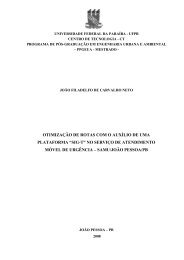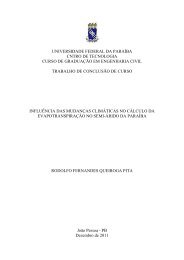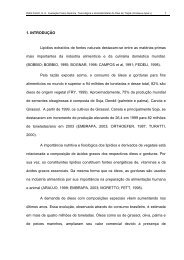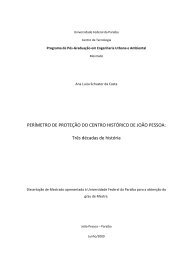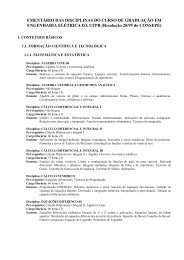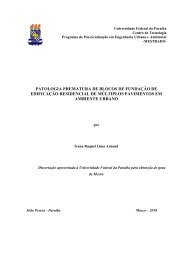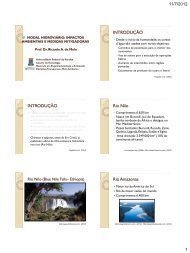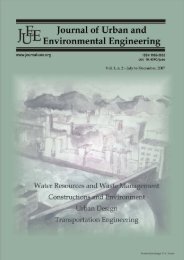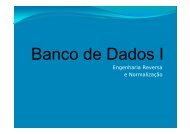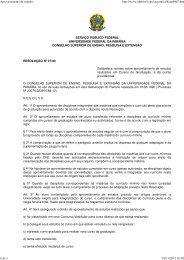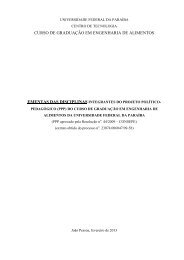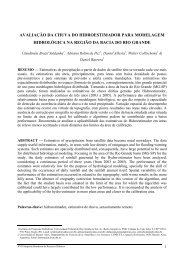editorial team
editorial team
editorial team
Create successful ePaper yourself
Turn your PDF publications into a flip-book with our unique Google optimized e-Paper software.
Ravindran and Nagendran<br />
35<br />
of interval and specific timings such as mornings,<br />
evenings, afternoon, leave days, working days and<br />
specific readings were tabulated.<br />
With the calculated readings in was clearly evident<br />
that Anna University campus is not much affected by<br />
the noise pollution but in certain areas standard<br />
measures are to be taken to bring down the noise level<br />
to ambient level. Areas such as Power house,<br />
Canteens, etc were to be isolated from the main utility<br />
areas such as class rooms, laboratories, library etc and<br />
special noise barricades are to be provided over the<br />
front side entrance or the wall height can be increased<br />
to a certain level so that the impact of noise in<br />
minimized.<br />
Vehicular traffic inside the campus is to be banned<br />
completely to preserve the noise pollutions inside the<br />
campus and the classrooms are to be provided with<br />
proper sound facilities such as noise absorbents inside<br />
the class rooms. When building new hostel blocks or<br />
class rooms special care is to be taken to locate them in<br />
an area where the noise level is minimum.<br />
Social developmental perspective<br />
Even though all the studies were done and many<br />
solutions were provided for the sustainable utilization<br />
of resources and the effective reduction in any waste<br />
generation, the concepts was perfectly shaped if the<br />
social element is also added into the project such as<br />
educating the students and staff for the same. In this<br />
paper the solution to improve the social awareness<br />
among the students and faculties of the campus was<br />
analyzed and a solution to improve the present<br />
scenario was given. For analyzing this area initially a<br />
brain storming session was done with other department<br />
heads, staffs, students, with a questionnaire focusing<br />
primarily on the issues related to social awareness<br />
creation for the staffs and the students. Also a<br />
questionnaire about the current awareness on<br />
environmental preservation is prepared, given to<br />
representative sample of students and staff members.<br />
Social Impact analysis<br />
Universities were not just bricks and mortar; it’s made<br />
up of the people using the facilities inside the campus.<br />
The maintenance and the resource utilization inside the<br />
campus are directly in the hands of the students and<br />
staff using the University resources for day to day<br />
operations. Most of the resource utilization is by the<br />
student community for their study aids such as<br />
laboratories, library, classrooms, etc and they play a<br />
major role in saving the resource utilization inside the<br />
campus. It is found after discussing with the concerned<br />
authorities that most of the students are unaware of the<br />
magnitude of resource utilization inside the campus for<br />
day to day operations and it’s mandatory for the<br />
University authorities to inculcate knowledge among<br />
the student and staff community on the preservation<br />
and optimization of resources inside the university.<br />
This starts with small posters inside the class rooms<br />
for saving electricity and water which are major<br />
resources wasted inside the campus, which may<br />
directly results in huge savings to the University<br />
authorities. Students should be made aware of the total<br />
amount of water and electricity usage inside the<br />
campus for the operations and they should be well<br />
known to the methods of savings it.<br />
Posters and hand outs were prepared for distributing<br />
to the students to increase the awareness among them<br />
about the resource savings that can be done by them<br />
using simple methods such as switching off lights and<br />
fans while leaving, using water properly without<br />
wastage in laboratories, canteens, toilets , etc. It’s also<br />
suggested to the University authorities to make some<br />
simple rules as mandatory for the students to form a<br />
<strong>team</strong> of students in all courses to improve the methods<br />
of resource usage while in the University.<br />
This will be a major tool for resource optimization<br />
(Bailey, 1997) since the students will normally used to<br />
the conditions soon if it was practiced particularly in<br />
the hostel blocks students should be advised about<br />
saving electricity and water which are prime resources.<br />
Using GIS for sustainable development<br />
Geographical Information System (GIS) is a tool to<br />
look at data that has a location. A GIS transforms data<br />
into information by integrating different data sets,<br />
applying focused analysis and providing output, in<br />
such a way that it supports decision making. It is tool<br />
for managing spatial information. The key objective of<br />
a GIS is the analysis of complex relationships<br />
contained in a database.<br />
These relationships, representing a multitude of<br />
geographic, descriptive and statistical data, must be<br />
readily accessible for a variety of queries and analyses.<br />
By exploring the spatial dimension, spatial analysis<br />
introduces a framework that can largely enhance<br />
decision making and problem solving.<br />
Advantages of using GIS for environmental<br />
protection<br />
GIS provides wider range of environmental protections<br />
applications such as:<br />
• Disaster Management<br />
Journal of Urban and Environmental Engineering (JUEE), v.4, n.1, p.29-36, 2010



